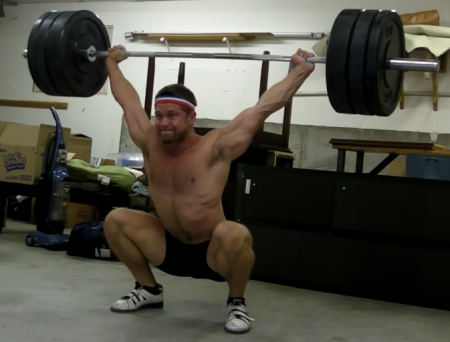This topic has been festering on the internet for a few days because Mark Rippetoe wrote an article titled “The Fallacy of High-Rep Olympic Lifting” for T-Nation. By the way, I see a comparison between Rip and Stone Cold Steve Austin in his heel (bad guy) days in WWF — he’d come out and buck the system and some people hated him, some loved him for it, yet both fan groups paid attention while another group just said, “Get this guy outta here, I wanna watch Shawn Michaels hit a side-lunge-front-double-bi.”
Rip’s article basically says that using the Olympic lifts is misguided because they are injurious, reinforce poor mechanics, and aren’t optimal for conditioning anyway. You also get the gist of an anti-CrossFit sentiment. Various CrossFit-oriented responses will point out that the end will justify the means in the pursuit of well rounded conditioning (or maybe just CrossFit capability).
Well, I’m a fence rider. I always tell people that there are things I like and dislike in CrossFit, but overall I have a favorable opinion (more on this from a couple years ago. Edit: From 2012). Anyway, let’s ignore the idea of CrossFit and focus on the primary topic: the deabte of high rep Olympic weightlifting movements in conditioning.
Do they have a place in a training program? Like all programs, it depends. If someone is doing high-rep, light-weight snatches or clean and jerks, can their form fall apart? Of course. Can someone do a conditioning workout and maintain technique? Certainly, but they’d probably have to slow the overall workout down a little. I agree with Kelly Starrett in that performing snatches or clean and jerks in a conditioning session is not only acceptable, but that they can provide meaningful training adaptations. The trainee in question would need to have the appropriate strength, mobility, and technique to even be considered for such a workout.
Snatches and cleans are beautiful movements where a lifter creates tension in their system, explodes to release the tension, and then creates tension in a completely new position. They are the epitome of full body, technically demanding lifts. Not only do they have their gross motor pathway demands (e.g. proper pulling position, proper mechanics through all phases of the pull, proper receiving position, and proper recovery), but they have acute motor pathway demands (e.g. keeping the torso solid and not extending or flexing the spine, maintaining external rotation in the hips and shoulders when applicable, etc.).

A 5 year old picture of cleans in a conditioning workout. It’s possible to maintain technique while fatigued.
A trainee who plays a sport or has a physically demanding job can use snatches and cleans to test whether they can maintain gross and acute motor pathways when their muscles are tired and they are breathing hard — the latter of which is extremely important for anyone who has to run around with heavy gear on. If a soldier can’t maneuver his battle space with proper mechanics, it can lead to acute injury or chronic irritation that will deem him nonoperational.
The point is that movements like snatches and cleans can help teach a trainee to maintain positioning in extreme fatigue so he can learn what is right and what is wrong. I’ve worked with a lot of athletes and military personnel, and both parties are guilty of reverting to bad positioning in the heat of the moment.
Should these populations bother with the weightlifting movements if they perform them poorly? Of course not; training would only serve as a source of injury. But it’s up to the coaches to develop their trainees to the point that they can do lots of technically sound cleans in a row. That’s one thing CrossFit has taught us: doing the high reps matters not for the sake of increasing the work output, but having proper mechanics to reduce the wear and tear on the body. I’m not so sure CrossFit would emphasize the latter, but it’s up to us as coaches and programmers to learn and acknowledge that.
Are there are a lot of CrossFit coaches who have no business putting someone in a workout with high rep snatches? Fuck yes. Is that a CrossFit problem? I don’t care, because at the end of the day it’s the responsibility of individual coaches to properly prepare their trainees for whatever workout they create for them. Instead of lambasting the use of high rep Olympic lifts and CrossFit, let’s use this as an opportunity to learn and get better as coaches. And that means developing a trainee’s mobility, getting them strong, and teaching them how to lift technically sound before challenging them with fatigue and high ventilation rates.

